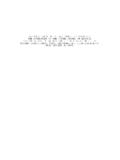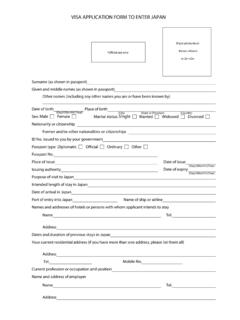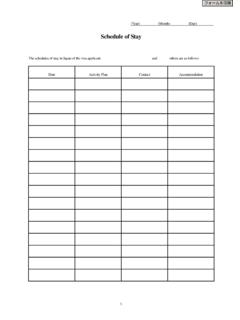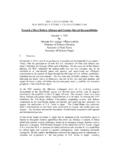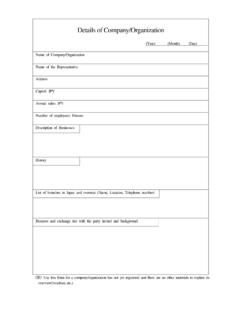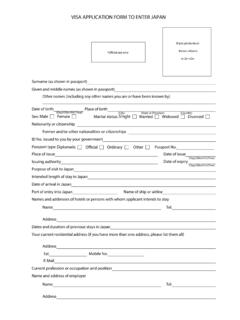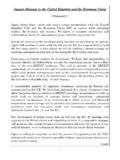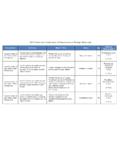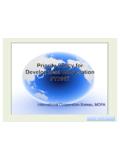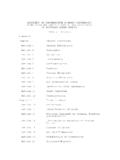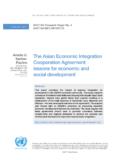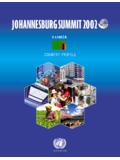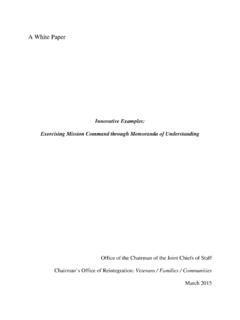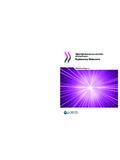Transcription of CO FORMAT FOR ASEAN MEMBER STATES Original (Duplicate ...
1 CO FORMAT FOR ASEAN MEMBER STATES Original (Duplicate/Triplicate) Reference No. 1. Goods consigned from (Exporter's name, address, country) THE agreement ON comprehensive economic partnership among MEMBER STATES OF THE ASSOCIATION OF SOUTHEAST ASIAN NATIONS AND JAPAN (AJCEP agreement ) CERTIFICATE OF ORIGIN 2. Goods consigned to (Importer s/Consignee's name, address, country) FORM AJ Issued in _____ (Country) See Notes Overleaf 3. Means of transport and route (as far as known) 4. For Official Use Shipment date Preferential Treatment Given Under AJCEP agreement Vessel's name/Aircraft etc. Preferential Treatment Not Given (Please state reason/s) Port of discharge.
2 Signature of Authorised Signatory of the Importing Country 5. Item 6. Marks and 7. Number and type of 8. Origin criteria 9. Quantity (gGross 10. Number and number numbers of packages, description of (see Notes or netweight date of Packages goods (including quantity overleaf) or other quantity) Invoices where appropriate and HS and value ( number of the importing Party) if required by exporting Partyonly when RVC criterion is used) 11. Declaration by the exporter 12. Certification The undersigned hereby declares that the above It is hereby certified, on the basis of control details and statements are correct; that all the goods carried out, that the declaration by the were produced in exporter is correct.
3 (Country) and that they comply with the requirements specified for these goods in the AJCEP agreement for the goods exported to .. (Importing Country) .. Place and date, name, signature and company of Place and date, signature and stamp of authorised signatory certifying authority 13. Third Country Invoicing Back-to-Back CO Issued Retroactively NOTES: 2 1. The following countries shall use this form for the purpose of preferential tariff treatment under the agreement on comprehensive economic partnership among MEMBER STATES of the Association of Southeast Asian Nations and Japan (AJCEP agreement ) : BRUNEI DARUSSALAM CAMBODIA INDONESIA LAOS MALAYSIA MYANMAR PHILIPPINES SINGAPORE THAILAND VIETNAM 2.
4 CONDITIONS: To enjoy preferential tariff treatment under the AJCEP agreement , goods exported to any of the Parties to the AJCEP agreement should: (i) fall within a description of goods eligible for concessions in the importing Party; (ii) comply with the consignment conditions in accordance with Article 31 of the AJCEP agreement ; and (iii) comply with the origin criteria in Chapter 3 of the AJCEP agreement . 3. ORIGIN CRITERIA: For goods that meet the origin criteria, the exporter should indicate in box 8 of this Form, the origin criteria met, in the manner shown in the following table: Circumstances of production or manufacture in the country named in box 11 of this form: Insert in box 8 (a) Goods satisfying subparagraph (c) of Article 24 of the AJCEP agreement PE (b) Wholly obtained goods satisfying Article 25 of the AJCEP agreement WO (c) Goods satisfying paragraph 1 of Article 26 of the AJCEP agreement CTH or RVC (d) Goods satisfying paragraph 2 of Article 26 of the AJCEP agreement - Change in Tariff Classification - Regional Value Content - Specific Processes CTC RVC SP Also, exporters should indicate the following where applicable.
5 (e) Goods which comply with Article 28 of the AJCEP agreement DMI (f) Goods which comply with Article 29 of the AJCEP agreement ACU 4. EACH ITEM SHOULD QUALIFY: All items in a consignment should qualify separately in their own right. This is of particular relevance when similar items of different sizes are exported. 5. DESCRIPTION OF GOODS: For each good, the HS tariff classification number of the importing Party should be indicated at the six-digit level. The description of the good on a certificate of origin should be substantially identical to the description on the invoice and, if possible, to the description under the HS for the good. With respect to subheading and , in an exceptional case where the good is a specific product requiring a special description ( sake compound and cooking sake (Mirin) of subheading , beverages with a basis of fruit, of an alcoholic strength by volume of less than 1% of subheading quilts and eiderdowns of ), such description of specific products should be indicated.
6 6. FREE-ON-BOARD (FOB) VALUE: The FOB value in Box 9 shall be reflected only when the Regional Value Content criterion is applied in determining the origin of goods. In the case of goods exported from and imported by Cambodia and Myanmar, the FOB value shall be included on the Certificate of Origin, irrespective of the origin criteria used, for 2 years upon the implementation of this new arrangement. 7. INVOICES: Indicate the invoice number and date for each item. The invoice should be the one issued for the importation of the good into the importing Party. 8. THIRD COUNTRY INVOICING: In cases where invoices are issued by a third country, in accordance with Rule 3 (d) of Implementing Regulations, the Third Country Invoicing box in box 13 should be ticked ( ). The number of invoices issued for the importation of goods into the importing Party should be indicated in box 10, and the full legal name and address of the company or person that issued the invoices shall be indicated in box 7.
7 In an exceptional case where the invoice issued in a third country is not available at the time of issuance of the certificate of origin, the invoice number and the date of the invoice issued by the exporter to whom the certificate of origin is issued should be indicated in box 10. The Third Country Invoicing in box 13 should be ticked, and it should be indicated in box 7 that the goods will be subject to another invoice to be issued in a third country for the importation into the importing Party, identifying in box 7 the full legal name and address of the company or person that will issue another invoice in the third country. In such a case, the customs authority of the importing Party may require the importer to provide the invoices and any other relevant documents which confirm the transaction from the exporting Party to the importing Party, with regard to the goods declared for import.
8 9. BACK-TO-BACK CERTIFICATE OF ORIGIN: In the case of a back-to-back CO issued in accordance with paragraph 4 of Rule 3 of the Operational Certification Procedures, the Back-to-Back CO box in box 13 should be ticked ( ). 10. ISSUED RETROACTIVELY: In cases of a CO issued retroactively in accordance with Rule 7 of the Implementing Regulations, the Issued Retroactively box in box 13 should be ticked ( ). 11. CERTIFIED TRUE COPY: In cases of certified true copies, the words CERTIFIED TRUE COPY should be indicated in box 12 in accordance with Rule 5 of the Implementing Regulations.
